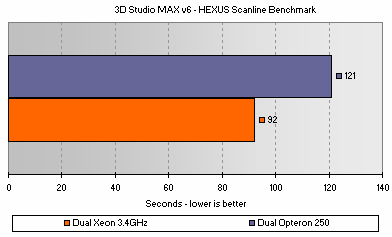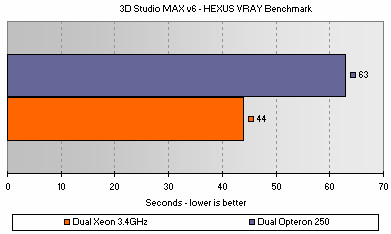3D Studio Max v6
3D Studio Max v6 bundles a basic SMP-aware scanline renderer, and we combine that with the commercial VRAY renderer plug-in to create a couple of repeatable benchmarks using a HEXUS scene. The tests are entirely system limited, mostly on the CPU. HyperThreading is a win in 3D Studio Max v6 using both renderers, so the Xeons should do well.Scanline renderer

The Opteron 250 system is some 30% slower than the dual Xeons with HyperThreading. Their four presented processors are the reason why. The scanline rendering process is an inherently parallel process, so executing as many render threads as possible is the basic key to good performance. Tweaking that process for HyperThreading enhances that performance even further. Turn HT off and the Xeons still come out on top in this test, but by a much smaller margin.
VRAY renderer

This time the Opteron system is over 40% slower, the VRAY renderer enjoying the Xeons even more this time around. The light-casting raytracer is usually used for global illumination in animations, although it works just fine with static scenes. In an animation, VRAY calculates an initial light pass for the scene, then a difference pass for objects that have moved, minimising the impact of raytracing in terms of render time. Thankfully the scene we render is very simple with only a single light source, so it's quick.









